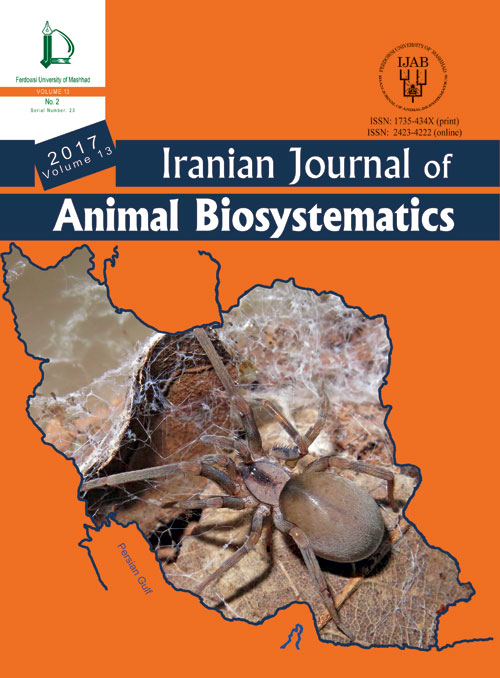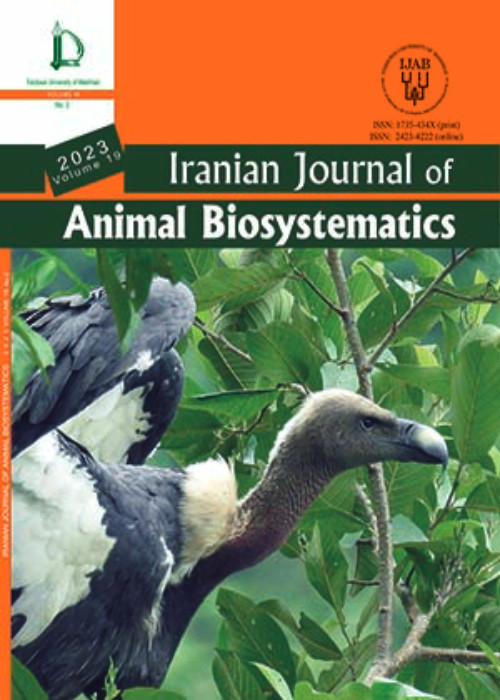فهرست مطالب

Iranian journal of animal biosystematics
Volume:13 Issue: 2, Summer-Autumn 2017
- تاریخ انتشار: 1396/09/10
- تعداد عناوین: 14
-
-
Page 137The genus Caradrina Ochsenheimer, 1816 is restricted to Holarctic and Ethiopian regions. Small inconspicuous appearance of its species is such that determination of the well over 150 species is one of the most difficult problems among all Noctuidae. According to light trap samplings which were made in different parts of Iran during 2010-2016, the present paper offers new data on the distribution of Caradrina species in Iran and reports Caradrina turcomana Hacker, 2004, as a new record for the Iranian fauna. Furthermore, we provide a catalogue of the genus Caradrina of Iran including 56 species and 11 subspecies togeather with available information on the type locality, synonyms, distribution and bionomics for all of the recorded species as well as discussion on the recent relevant publications.Keywords: Caradrina, checklist, Iran, new record, Caradrina turcomana
-
Page 159Based on this survey 23 species of family Laelapidae have been identified which three species of them are reported as new for Iranian mites fauna, that are marked with asterisk. The list of identified genera and species is as follows: Laelapidae: Gaeolaelaps aculeifer (Canestrini, 1884); G. oreithyiae (Walter and Oliver, 1989); G. angustus (Karg, 1965); G. kargi (Costa, 1968); G. nolli (Karg, 1962); G. khajooii Kazemi, Rajaei and Beaulieu, 2014; Pneumolaelaps (Hypoaspisella) linteyini (Samsinak, 1964); P. (H.) berlesei* (Hirschmann, 1969);Cosmolaelaps vacua (Michael, 1891); C. lutegiensis (Shcherbak, 1971); C. malakutsilus* Rosario, 1981; C. ornatus (Berlese,1903); C. angustiscutatus (Willmann, 1951); Laelaspis astronomicus (C. L. Koch, 1839); L. equitans (Michael, 1891); Ololaelaps sellnicki* Bregetova and Koroleva, 1964; Euandrolaelaps karawaiewi (Berlese, 1903); Hypoaspis larvicolus Joharchi and Halliday, 2011; Pogonolaelaps canestrinii (Berlese, 1903); Gymnolaelaps artavilensis Joharchi and Halliday, 2013; Pseudoparasitus dentatus (Halbert, 1920); Androlaelaps casalis (Berlese, 1887); A. shealsi (Costa, 1968)Keywords: Iran, Mesostigmata, mite, new record, soil, taxonomy
-
Page 171The hermit crabs in the intertidal zone of the Hormuz Island, Persian Gulf, were identified by seasonal sampling at six intertidal stations during 20102011. Nine species were identified, including one Coenobitidae (Coenobita scaevola) and eight Diogenidae (Clibanarius signatus, C. longitarsus, Diogenes avarus, D. planimanus, D. tirmiziae, D. karwarensis, Areopaguristes perspicax, Dardanus tinctor). All species in this study are new records for the Hormuz Island. Information on the habitats and geographical distribution of these crabs in the island is presented.Keywords: Identification, hermit crab, new records, Hormuz Island, Persian Gulf
-
Page 183In this paper, four genera (Brommella, Siwa, Trygetus and Turkozelotes) and 26 species are recorded for the spider fauna of Iran for the first time. In addition, new provincial records are provided for 103 species. As a result, the total number of spider species known from this country is raised to 696.Keywords: Iranian Plateau, Middle East, new records, range extensions
-
Page 199A survey of species belonging to Pardosa monticola species group from Iran showed a new report. A detailed study reveals that the only female specimen from West Azerbaijan Province belongs to P. colchica Mcheidze, 1946. Characters for distinguishing P. colchica and morphologically similar P. pontica (Thorell, 1875) are given and illustrated. The two species differ in colour and spination.Keywords: Wolf spiders, Aranei, Pardosini, monticola-group, Middle East, West Azerbaijan
-
Page 207The tribes Phaeogenini Förster, 1869 and Platylabini Berthoumieu, 1904 (Hymenoptera: Ichneumonidae) were studied in Golestan province, Northeastern Iran, during 2015-2016. The specimens were collected using Malaise traps and sweeping nets. Totally, 8 species belonging to 6 genera were identified which among them, two genera including Misetus Wesmael, 1845 and Stenodentus Berthoumieu, 1897 from the tribe Phaeogenini were new records for the fauna of Iran. With this study, the number of Iranian recorded species of Phaeogenini increased to 24 (14 genera). An identification key to the collected genera of Phaeogenini is also provided. The descriptions of these new Iranian species of Phaeogenini, Stenodontus marginellus, Stenodontus meridionator and Misetus oculatus are provided along with morphological diagnostic characters for all of the collected species.Keywords: Hymenoptera, Iran, new records, fauna, Misetus, Stenodentus
-
Page 221There are few papers about the fauna of the mantids in Iran and should be considered as poorly known taxon in Iran. New faunistic records of 10 species of mantids for the fauna of Iran are presented. Seven species- Empusa fasciata, E. hedenborgii, E. pennicornis (Empusidae), Bolivaria brachyptera, Ameles persa (Mantidae), Iris nana, I. polystictica (Tarachodidae) are new records for the mantid fauna of Iran.Keywords: Mantodea, Alborz Mountain, Iranian Plateau, New records
-
Page 229We studied 1140 base pairs of mitochondrial cytochrome b gene of small shrews from Iran. Using previous published data for Suncus Ehrenberg 1832, phylogenetic trees showed affiliation of Iranian haplotypes to Madagascan Pgymy Shrew, Suncus madagascariensis that is the first report of the species for Iranian plateau, questioning the presence of Suncus etruscus for the country. Kimura 2 parameter genetic divergence of 5.4% between the two nominative geographic clades, etruscus and madagascariensis (the Western and Eastern) is located beyond of intraspecific divergence for mammalian cytochrome b (2.4%). This finding reflects the importance of molecular data to discriminate groups, when traditional approaches are not adequate, as well as it sheds more light on the current geographic range of small shrews.Keywords: Iran, Suncus etruscus, Suncus madagascariensis
-
Page 237New advances in molecular techniques are substantially reshaping our understanding of taxonomy. However, combining molecular and morphologic data is a prevailing trend towards integral taxonomy. In a genetic frame, two nominal species, Crocidura gmelini and C. suaveolens have recently been lumped into one species. This study aimed to evaluate this hypothesis morphologically. For this, 42 specimens from northern Iran classified either as C. gmelini or C. suaveolens were subjected to the geometric morphometrics analyses. Landmark based method on labial side of mandible along postcranial morphology showed profound resemblance, provide further supports for genetic results.Keywords: Crocidura gmelini, Crocidura suaveolens, Geometric morphometrics
-
Page 247This paper presents the south westernmost record of the Turkmenian Fat- Tailed Gecko, Eublepharis turcmenicus Darevsky, 1978, from Khorasan Razavi province, Iran. Five specimens (three adult females, one adult and one juvenile male) were studied from 15 km southwestern of Azadvar village, about 34 km north western of Joghotai County in Razavi Khorasan province. Morphometric and meristic characters of these specimens, coloration, and habitat of the species are presented in this paper.Keywords: Eublepharis turcmenicus, new records, Khorasan Razavi, Iran
-
Page 263In this study, the adult cranial osteology of Trachylepis vittata and Lacerta media media collected from Kermanshah Province, western Iran, are described and compared based on seven dry skull preparations. Herein, variation patterns are considered in morphology of the cranial, elements of position in the skull structure and elements of connection together between the skull of two species in order to use in phylogenetic analyses and systematic studies. The skull roof, the palate, the mandible, the teeth within each of these two species discussed and compared. The obvious differences are as follows: A complete loss of any one bone was not discerned in the study of the skull of both species, but a obvious decrease was watched in the postorbital bones in T. vittata. Articulations of the jugal, the squamosal and the palatine in the various regions. The variations in form, size and position in bones such as: The nasal processes of the premaxilla, the parietal, the supraoccipital, otoccipital, the paraoccipital process, prearticular, the dentary.Keywords: osteology, postorbital, systematic, western Iran, phylogenetic analyses, cranial
-
Page 275In this research on the Banded Skink, Trachylepis vittata (Olivier, 1804), the patterns of geographic variation was analyzed for four meristic and 21 morphometric characters of this species belonging to two populations, one from western Iran and the other from Turkey. The univariate analyses including Independent sample T-test and one-way ANOVA (LSD Test) were used to explore the patterns of geographic variation. Results of the analyses indicated significant differences and a relatively clear pattern of separation between the two studied populations of T. vittata.Keywords: Trachylepis vittata, Geographic variation, Western Iran, Turkey


